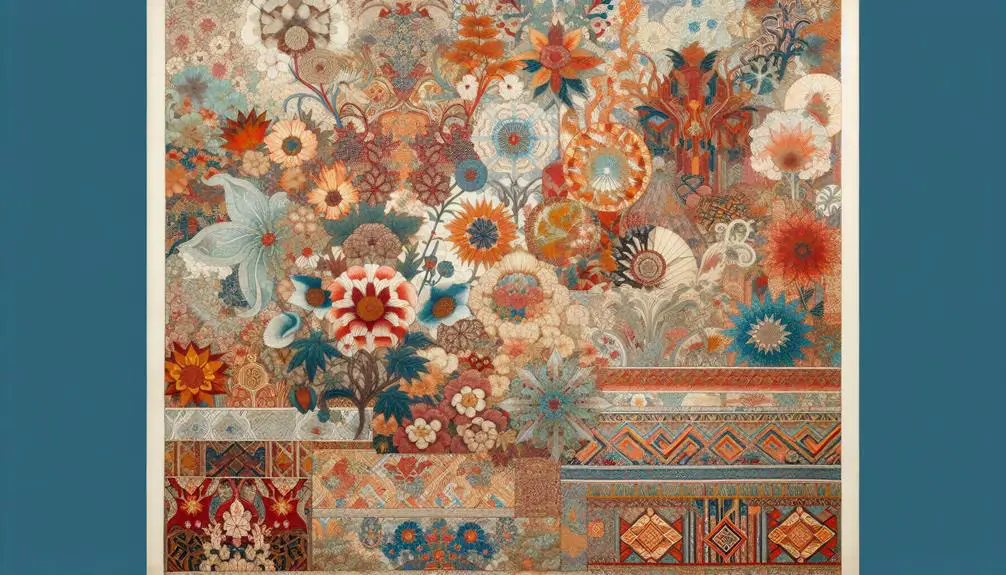When you consider the evolution of textile patterns, you might wonder how ancient symbolic designs transformed into the intricate weaves of the Medieval era and the artistic exuberance of the Renaissance. The Industrial Revolution's technological advancements, like the Jacquard loom, revolutionized pattern production, making it more accessible and varied. As you progress into the 20th century, innovations such as computer-aided design and synthetic fibers brought about a new era of creativity and practicality. Today, the blend of tradition, technology, and contemporary trends shapes modern textiles in ways you might find both surprising and enlightening.
Table of Contents
Key Takeaways
- Ancient textiles featured intricate designs with deep cultural symbolism, passed down through generations.
- Medieval and Renaissance textiles used techniques like brocade and damask, showcasing both functionality and artistic exuberance.
- The Industrial Revolution introduced mechanized production and the Jacquard loom, democratizing complex patterns.
- 20th-century innovations included synthetic fibers and Computer-Aided Design, increasing durability and production speed.
- Modern textiles emphasize sustainability, using eco-friendly materials and digital printing for rapid prototyping and customization.
Ancient Textile Patterns
Ancient textile patterns, often rich in symbolism, provide a fascinating glimpse into the cultures that created them. When you explore these intricate designs, you're not just looking at fabric; you're immersing yourself into the very essence of ancient civilizations. Ancient weaving techniques were more than mere craftsmanship; they embodied the cultural significance and daily life of the people.
Each pattern and color had a meaning, often conveying stories or indicating social status. The techniques used were passed down through generations, making each textile a piece of living history.
Preservation efforts are essential in maintaining these ancient treasures. Without proper care, these textiles would deteriorate, losing the stories they carry. Modern interpretations of these patterns allow us to appreciate and incorporate their beauty into contemporary designs.
By studying and preserving ancient textiles, we guarantee that the knowledge and artistry of past cultures continue to inspire and educate future generations. You'll find that understanding these ancient weaving techniques and their cultural significance not only enriches your appreciation of history but also enhances your creative endeavors.
Medieval and Renaissance Designs
During the Medieval and Renaissance periods, textile patterns became more elaborate and reflected the growing influence of European art and culture.
You'd find that Medieval weaves were intricate, often featuring geometric designs and symbolic motifs that conveyed religious and social messages. These weaves utilized techniques such as brocade and damask, showcasing a high level of craftsmanship.
In the Renaissance, textiles evolved further, embracing the era's artistic exuberance.
Renaissance tapestries stood out with their detailed depictions of historical events, mythology, and nature. These tapestries weren't just decorative; they were also functional, providing insulation in the grand halls of castles and manors.
The designs displayed a mastery of perspective and shading, reflecting the Renaissance's broader artistic advancements.
Patterns of the Industrial Revolution
As the Renaissance gave way to the Industrial Revolution, textile patterns underwent a dramatic transformation driven by technological advancements and mass production. You saw the rise of mechanized production, which revolutionized the way textiles were designed and manufactured. Gone were the days of handwoven fabrics; factory production now enabled intricate patterns to be replicated with unprecedented precision and speed.
Technological advancements such as the spinning jenny, power loom, and Jacquard loom played pivotal roles in this transformation. These machines allowed for the creation of complex, repeatable designs that were previously unachievable by hand. The Jacquard loom, in particular, introduced the concept of programmable patterns, making it possible to produce intricate designs on a mass scale.
With factory production, the availability of patterned textiles increased exponentially. This democratization of design meant that elaborate patterns, once reserved for the elite, became accessible to the broader public. You could now find a variety of patterns reflecting botanical, geometric, and even exotic themes, each produced efficiently and consistently.
In essence, the Industrial Revolution marked a turning point where the artistry of textile patterns became intertwined with the efficiency of mechanized production, setting the stage for the modern textile industry.
20th Century Innovations
Building on the momentum of the Industrial Revolution, the 20th century introduced groundbreaking innovations that further transformed textile patterns and production methods. With advancements in textile machinery, you saw a shift from the 19th century inventions to automated looms and synthetic fibers. These innovations drastically increased production speed and diversified design possibilities.
One remarkable development was the Jacquard loom, which allowed for intricate patterns to be woven into fabric with minimal manual intervention. This machine laid the groundwork for more sophisticated textile machinery in the 20th century. Additionally, the introduction of synthetic fibers like nylon and polyester revolutionized the industry by providing durable, versatile alternatives to natural fibers.
Here's a closer look at some key innovations:
| Innovation | Impact on Textile Patterns |
|---|---|
| Jacquard Loom | Enabled complex patterns with ease |
| Synthetic Fibers | Introduced new textures and durability |
| Computer-Aided Design | Allowed for precise and intricate patterns |
| Automated Looms | Increased production speed and pattern complexity |
With these advancements, you could achieve unprecedented levels of detail and efficiency in textile production. The integration of computer-aided design further pushed the boundaries, allowing for digital precision in pattern creation. These innovations set the stage for the textile industry's modern era.
Modern and Contemporary Textiles
In today's world, textile patterns have reached new heights of creativity and technological sophistication. You're witnessing an era where sustainability trends and digital printing technologies are revolutionizing the industry.
Designers and manufacturers are now more conscious of their environmental impact, integrating eco-friendly materials and processes into their workflows. Organic fibers, recycled fabrics, and low-waste production techniques are becoming standard practices, ensuring that the textiles you use aren't only beautiful but also sustainable.
Digital printing technologies have opened up a world of possibilities, allowing for intricate and vibrant designs that were once unimaginable. Unlike traditional methods, digital printing lets you create highly detailed patterns with fewer resources and less waste.
This technology enables rapid prototyping and on-demand production, making it easier for designers to bring their innovative ideas to life quickly and efficiently. Additionally, digital printing allows for customization on an unprecedented scale, giving you the power to tailor textiles to your exact specifications.
Frequently Asked Questions
What Are the Key Factors Influencing Textile Pattern Trends Today?
Imagine stumbling upon a bustling market; you'll see consumer preferences and market demands shaping textile trends. Globalization and the fashion industry also play significant roles, intertwining cultures and styles, creating a dynamic, ever-evolving pattern landscape.
How Do Cultural Exchanges Impact Textile Pattern Development?
Cultural exchanges impact textile pattern development by blending diverse aesthetics. Trade influences and artistic exchanges bring new ideas and techniques, enriching designs. You'll see unique patterns emerging from these dynamic interactions, reflecting a fusion of global creativity.
What Are the Environmental Implications of Textile Pattern Production?
Did you know that textile production accounts for 10% of global carbon emissions? You should adopt sustainable practices, like using eco-friendly dyes, to reduce environmental impact and promote a healthier planet for future generations.
How Do Technological Advancements Affect the Creation of New Textile Patterns?
Technological advancements revolutionize your textile pattern creation by harnessing digital innovations for design inspiration and utilizing sustainable materials influenced by various artistic styles. You can explore limitless possibilities while maintaining an eco-friendly approach.
What Role Do Designers Play in the Evolution of Textile Patterns?
Like Da Vinci with a canvas, you, as a designer, wield immense influence over textile patterns. Your artistic vision shapes trends, blending tradition and innovation, driving the evolution of patterns that captivate and inspire future generations.
- How to Do Speckle Dyeing With Powder Dyes - July 14, 2025
- The Chevron Tie-Dye Pattern: A Step-by-Step Guide - July 14, 2025
- How to Tie-Dye a Double Spiral Pattern - July 14, 2025



